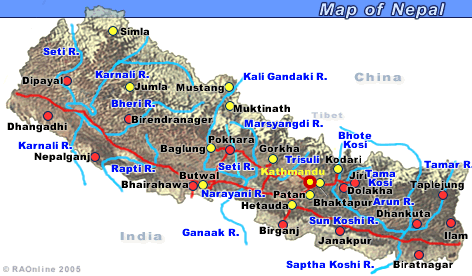 |
Nepal Tourism |
|
 |
Nepal Information |
|
|
 |
| White Water Raftings |
 |
Though
rafting was introduced in Nepal in 1970, commercial rafting started only
in 1975. In this rather short period of time Nepal has earned a reputation
for being one of the best destinations in the world for white-water rafting.
Even within a short distance of 100 miles, the topography varies significantly
leading to variation in the run of the rivers originating in high mountains
which pass through the middle hills before dropping dramatically in the
southern plains and joining the Ganges River System in India.
The waters
in Nepal offer eciting adventure for travellers, with choice ranging from
2 to 3 day trips to 2 to 3 week trips. Rivers are graded on the basis of
the ferocity of their rapids, and Nepal has rapids that range from 1 to
5+. Besides, rafting in Nepal offers options including paddling and kayaking.
The best time for rafting is from October through mid-December and March
through early May. So far the government has opened up 16 river sections
for commercial rafting.
 |
ACTIVITIES |
Arun
River, which is graded as 5, is one of the famous rivers of eastern
Nepal. The rafting begins at Tumlingtar and ends at Chatara,
Kartikeghat. The starting point can be approached either by flight
or by road. A short trek is required from both the airstrip and the bus
stop. Some portions of the river are smooth while some are rough and challenging.
After finishing the journey, rafters either drive back from Chatara via Biratnagar or fly from Biratnagar to Kathmandu.
Bheri
River rafting site in Nepalgunj can be reached by a half-hour
flight or a 627-kilometer drive from Kathmandu.
The rafting starts from Birendra Nagar and ends at Chisapani,
with the first section of the remote and relatively uneplored river having
many twists and turns. The gorge occasionally opens into valleys and small
villages. The trip can be continued with a jungle tour in the Bardiya
Wildlife Reserve. The number of rafters per year varied from 100 to
200 between 1990 and 2000.
Balephi
River is a tributary of Sunkoshi river. It offers a two day rafting
epedition. The starting point is located at Chanaute and ends at Chehere on the Sunkoshi river.
Bhotekoshi
River at grade 4 to 5 is a two-day run of pure adventure. The starting
point for rafting is at Baseri, above Barhabise and it ends
at Lamosangu. It is the steepest river rafted in Nepal with a span
of twenty-si kilometers.
Budhi
Gandaki River is a si-day run where the rafting starts at Arukhet and ends at Mugling along the Kathmandu-Narayanghat Highway.
Dudhkoshi
River offers a long rafting epedition of 13 days. The starting point
is at Bash and ending at Chatara.
Kali
Gandaki River (Kali
Gandaki Graben) winds
through remote canyons and deep gorges of intense rapids. Starting at Baglung,
one can raft down to Mirmi, Ramdighat. The run flows 120 km and
its challenges are continuous.
Karnali
River (Grade 4 to 5) located in the far west is the longest and largest
river in Nepal. It flows through steep, jagged canyons where the rapids
are tightly packed, offering challenging water at all flows. The rafting
starts at Bhanket and ends in Chisapani. It takes about 7
days to navigate the 90 kilometers of canyons and waterfalls. During most
of this trip, the wilderness is uninterrupted by human settlements.
Marsyangdi
River (Grade 4 to 5) offers a four-day long rafting beginning from
the village of Nagdi from Besisahar to Bimalnagar along the Prithivi Highway.
Seti
River (Grade 3 to 5) can be reached from Damauli, roughly 160
kilometers west of Kathmandu. Rafters encounter several rapids before reaching Trisuli
River.
Seti
Karnali River (Grade 4 to 5) in the far west is a tributary of Karnali
River and is twelve days rafting starting from Dauda to Chisapani.
The river is noted for its blue-green water and white sandy beaches.
Upper
Sunkoshi River offers a rafting length that starts from Khadechaur
behind the Sunkoshi Hydropower Station and ends at Dolalghat along the
Araniko Highway.
Lower
Sunkoshi River graded from 4 to 5 is one of Nepal's longest rafting
trips. The rafting site at Dolalghat is three hours drive from Kathmandu.
The run is 270 km and requires 9 to 10 days from Dolalghat to Chatara down in the Indo-Gangetic plains.
Tamor
River is a tributary of Saptakoshi River and drains the snows
of Kanchenjunga. The rafting in this river starts from Basantapur and ends at Chatara.
Tamakoshi
River is another tributary of the Saptakoshi. The rafting length
starts at Busti and ends at Chatara. Only a few rafters have
done this river in the past.
Trisuli
River, as indicated by data, is one of the most popular rivers in Nepali
for rafting. Due to its proimity to the capital city Kathmandu and easy
access, most rafters prefer trips on the Trisuli River. It is the cheapest
river trip available in Nepal. Rafting starts from Trisuli and ends
at Narayanghat.
Arun
River
Balephi
River
Bheri
River
Bhotekoshi
River
Budhi
Gandaki River
Dudhkoshi
River |
Kaligandaki
River
Karnali
River
Marsyangdi
River
Seti
River
Seti
Karnali River |
Sunkoshi
River (Lower)
Sunkoshi
River (Upper)
Tamakoshi
River
Tamor
River
Trisuli
River |
|
Source:
MOPE - State of the Environment/Eco-Tourism/2004
 |
|
Everest |
| More
information and pictures |
 |
|






